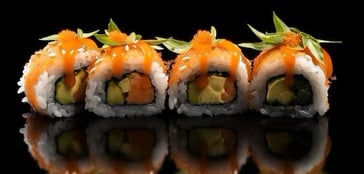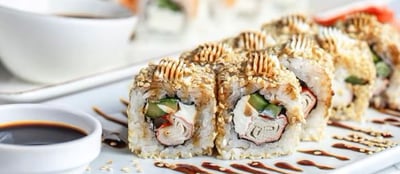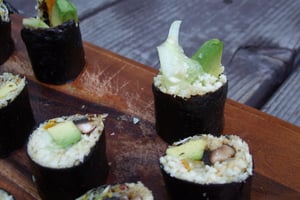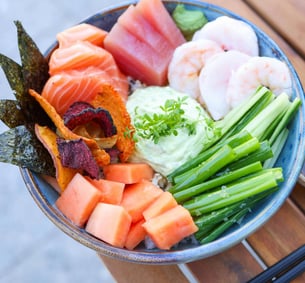The Real History of Sushi: It’s Not What You Think
Sushi is a global delicacy with deep historical roots, but its origins may surprise you. This blog explores how sushi evolved from ancient preservation methods to the refined cuisine we know today.
DipVai
2/6/20254 min read


Introduction: Sushi’s Surprising Story
When most people think of sushi, they picture pristine slices of fish artfully arranged on rice at upscale restaurants. However, the history of sushi tells a different story—one filled with practicality, preservation, and evolution over centuries. From its humble beginnings in ancient Asia to its modern status as a culinary icon, sushi’s journey is anything but what most would expect.
Ancient Origins: Preserving Fish for Survival
Sushi’s story begins not in Japan but in Southeast Asia over 2,000 years ago. The precursor to sushi was a method used to preserve fish, known as narezushi. Fish was packed in fermented rice, which created an acidic environment to prevent spoilage. The rice was discarded, and only the preserved fish was eaten.
This practice spread to Japan during the Yayoi period (300 BC–300 AD). Japanese ingenuity saw the value of the rice itself, leading to modifications that eventually turned fermented rice into part of the meal rather than mere preservation waste.
The Evolution of Sushi in Japan
By the Edo period (1603–1868), sushi had undergone significant transformations:
Haya-zushi (Early Quick Sushi): Instead of fermenting rice for long periods, cooks started seasoning rice with vinegar to mimic the tangy flavor of fermentation. This change made sushi faster to prepare and more palatable.
Nigiri Sushi: Perhaps the most recognizable form of sushi today, nigiri—hand-pressed rice topped with fresh fish—emerged in the bustling streets of Edo (modern-day Tokyo). This “fast food” version was portable and convenient, catering to busy city dwellers.
The street food culture of Edo played a key role in popularizing nigiri sushi, which was often sold by vendors much like food trucks operate today.
Sushi in the West: A Culinary Revolution
Sushi made its way to the United States in the 1960s, initially as a niche offering in Japanese communities. The pivotal moment came in the 1970s with the invention of the California Roll, which replaced raw fish with avocado and imitation crab to appeal to American palates.
This innovation paved the way for creative sushi rolls and adaptations, making sushi a mainstream sensation. Sushi chefs began incorporating local flavors and ingredients, resulting in iconic variations like the Philadelphia Roll and Rainbow Roll.
Myths and Misconceptions About Sushi
Myth 1: Sushi Means Raw Fish
Contrary to popular belief, the word “sushi” refers to the seasoned rice, not raw fish. Many types of sushi, such as vegetable rolls or cooked shrimp nigiri, don’t involve raw fish at all.Myth 2: Sushi Is Exclusively Japanese
While Japan refined and popularized sushi, its roots can be traced to other parts of Asia, particularly along the Mekong River basin.Myth 3: Sushi Is a Luxury Food
Historically, sushi was street food in Japan. Its modern association with fine dining is a relatively recent development.
Cultural Significance of Sushi
Sushi is more than just a meal—it’s a reflection of Japanese culture, emphasizing simplicity, balance, and respect for ingredients. The careful preparation of sushi embodies the Japanese principle of wabi-sabi, which finds beauty in imperfection and simplicity.
Even today, traditional sushi chefs undergo years of rigorous training to master techniques for preparing and serving sushi, highlighting the reverence for this culinary art form.
Health Benefits of Sushi
Beyond its cultural and historical significance, sushi offers numerous health benefits when consumed mindfully:
Rich in Omega-3 Fatty Acids: Sushi featuring fatty fish like salmon supports heart and brain health.
Low in Calories: Nigiri and sashimi options provide lean protein without excessive calories.
Nutrient-Dense Ingredients: Seaweed, often used in sushi, is packed with vitamins and minerals.
However, moderation is key, as some modern sushi variations can be high in sodium and calories due to sauces and fried components.
Modern Sushi: Innovation Meets Tradition
Sushi continues to evolve with global culinary trends:
Fusion Rolls: Creative combinations using flavors from Mexican, Korean, and other cuisines have become increasingly popular.
Plant-Based Sushi: Vegetarian and vegan sushi options, including rolls made with jackfruit, tofu, and plant-based seafood, are gaining traction.
Deconstructed Sushi Bowls: Also known as poke bowls, these offer a convenient, customizable way to enjoy sushi flavors without the traditional form.
Tips for Enjoying Sushi Like a Pro
Start Simple: Try traditional options like nigiri or sashimi to appreciate the flavors without distractions.
Use Minimal Soy Sauce: Dip the fish side, not the rice, to avoid overpowering the flavor.
Respect Wasabi: A small amount is enough—don’t mix it into the soy sauce.
Eat Fresh: The quality of sushi heavily depends on the freshness of the ingredients.
Final Bite: A Global Delicacy with Humble Roots
Sushi’s journey from a simple preservation technique to a global culinary sensation is a testament to its adaptability and cultural significance. Whether enjoyed at a high-end sushi bar or as a casual meal at home, sushi continues to captivate food lovers worldwide.
Understanding its rich history adds depth to every bite, reminding us that behind every piece of sushi lies a story of innovation, tradition, and cultural evolution.










Mexican Fusion Sushi


image : Freepik
Crab maki cream cheese
image : Freepik


Vegan Sushi
image : Flickr


Sushi Bowl
image : Pexels
Get in touch
itsusdipvai@gmail.com
